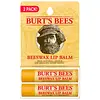What's inside
What's inside
 Key Ingredients
Key Ingredients

 Benefits
Benefits

 Concerns
Concerns

 Ingredients Side-by-side
Ingredients Side-by-side

Petrolatum
EmollientWater
Skin ConditioningTheobroma Cacao Seed Butter
EmollientLanolin
EmollientGlyceryl Stearate
EmollientBehenyl Alcohol
EmollientStearic Acid
CleansingUrea
BufferingCetyl Esters
EmollientPalmitic Acid
EmollientLecithin
EmollientLauryl Alcohol
EmollientMyristyl Alcohol
EmollientCetyl Alcohol
EmollientCamphor
MaskingMenthol
MaskingMethylparaben
PreservativeBHA
AntioxidantEugenia Caryophyllus Leaf Oil
MaskingSucralose
Skin ConditioningPropylparaben
PreservativeAroma
Eugenol
PerfumingPetrolatum, Water, Theobroma Cacao Seed Butter, Lanolin, Glyceryl Stearate, Behenyl Alcohol, Stearic Acid, Urea, Cetyl Esters, Palmitic Acid, Lecithin, Lauryl Alcohol, Myristyl Alcohol, Cetyl Alcohol, Camphor, Menthol, Methylparaben, BHA, Eugenia Caryophyllus Leaf Oil, Sucralose, Propylparaben, Aroma, Eugenol
 Reviews
Reviews

Ingredients Explained
These ingredients are found in both products.
Ingredients higher up in an ingredient list are typically present in a larger amount.
Lanolin is a wax secreted by animals with wool, such as sheep. It is a waterproof emollient.
Emollients help soften and moisturize the skin by creating a film. This film prevents moisture from escaping, helping the skin stay hydrated.
Unlike true fats, lanolin contains sterol esters instead of glycerides. It also contains fatty acids and alcohols.
Because lanolin comes from an animal, it is not considered vegan. Sheep secrete lanolin through sebaceous glands to help protect their skin from the environment.
The answer to this question depends on the brand itself. Being cruelty-free means a brand does not experiment or harm animals. We recommend looking into how brands source their lanolin. Lanolin is cruelty-free if it is gathered without harming the animal.
Learn more about Lanolin